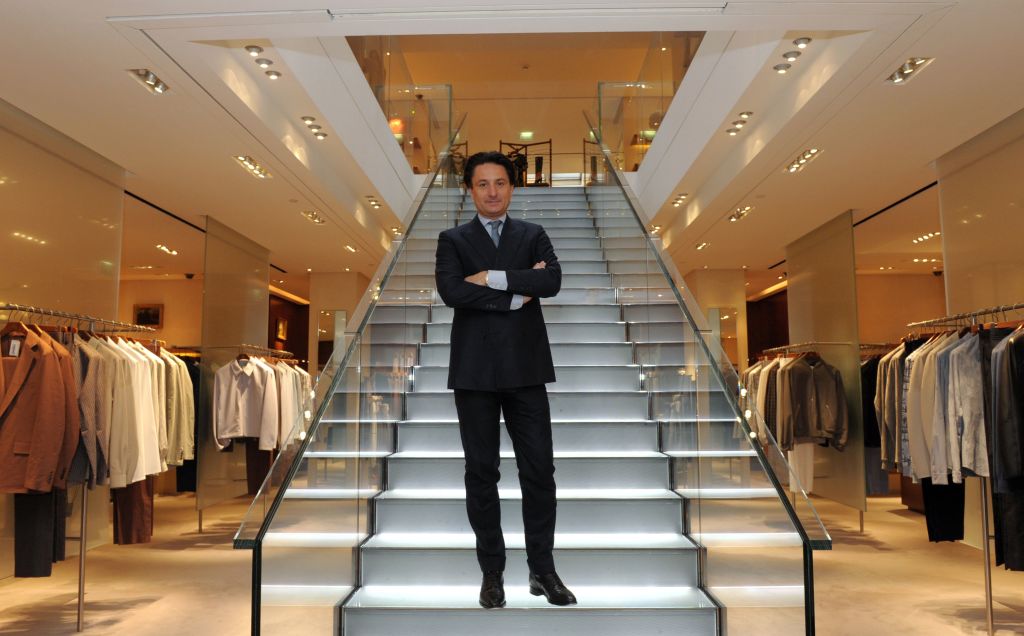- There are 16 heirs to the Hermès fortune, but two cousins, Pierre-Alexis and Axel Dumas, are at the head of the ultra-luxurious Parisian fashion house that rakes in billions of dollars in profit each year.
- Bloomberg estimates put the Dumas family fortune at $49.2 billion, making it one of the richest families in the world.
- Hermès, like Chanel, is one of just a handful of renowned retail businesses where a single family owns the controlling share.
- Hermès has become synonymous with exclusivity and perfection. Its renowned Birkin bag can cost up to six figures.
Thierry Hermès, an orphan, was skilled with leather – so skilled, in fact, that his main clients in the 19th century were royal families.
Six generations later, the Hermès family – and brand – is now known for its exclusive Parisian fashion house and a $49.2 billion fortune.
At the head of Hermès today are two cousins: Pierre-Alexis and Axel Dumas. Both are cochairmen of the brand. In addition, Axel is the CEO, and Pierre-Alexis is the company’s creative director, whose father, Jean-Louis, revolutionized Hermès, growing it into an international luxury retailer.
In the fashion industry, Hermès is the ultimate status symbol: Its signature Birkin bag takes more than 25 hours to make, costs up to six figures, and can be seen on the arms of celebrities and princesses.
Take a look at the history of Hermès and the family - which is now one of the richest - that turned it into a fashion powerhouse.
Thierry Hermès, who was highly skilled with leather, opened a shop in Paris in 1837.

Source: Vanity Fair
Hermès, at the time, specialized in saddles, taking precise measurements for horses and riders. Hand-stitched saddles took months to make. Perfection was expected every single time because many Hermès clients were European royalty, such as Napoléon III.

Source: Vanity Fair
Thierry Hermès' son, Émile-Charles Hermès, moved the Hermès flagship store in Paris to 24 Rue du Faubourg Saint-Honoré when he succeeded his father. It still stands there today. By the 20th century, Hermès had royals from all over the world on its client list.

Émile-Charles Hermès' sons, Adolphe and Émile-Maurice Hermès, succeeded him shortly after, ushering in the third generation of Hermès.
Source: Vanity Fair
In 1937, 100 years after Thierry Hermès opened his Paris shop, Hermès added square silk scarves to its repertoire. Today, a signature Hermès scarf can cost upward of $1,200.

Source: Vanity Fair
The fourth generation of Hermès was synonymous with the Dumas family. Robert Dumas took the head executive and artistic role in 1951 after the death of his grandfather, Émile-Maurice Hermès.

By this point, Hermès was a household name and was often described as a luxury brand. Hermès was also known for its long wait times and extraordinary price tags. But under Robert Dumas, sales were starting to slow, and ateliers had less and less to make.
Source: Vanity Fair
It was Robert Dumas who introduced belts and bags to the brand. He kept these new accessories in line with the brand's tradition, though: Scarves, belts, and bags were all decorated with bridles, bits, and saddles.

Source: Vanity Fair
After Robert Dumas died in 1978, his son, Jean-Louis Dumas, took the leadership role, a position he would keep for nearly three decades, transforming the company's financials from extreme lows to over $1 billion.

Under the helm of Jean-Louis Dumas, in a seven-year period in the 80s, Hermès saw sales grow from $82 million to $446.4 million.
Source: Women's Wear Daily, The New York Times
Jean-Louis Dumas not only diversified Hermès to include clothing and jewelry but also steered the company toward opening global operations and stores in a handful of countries. Today, there are over 300 stores in the world.

He even took the company public in 1993, though nearly 75% of the company still remains in the hands of the Dumas family.
Jean-Louis Dumas oversaw the opening of Hermès flagships, including those in Tokyo; Athens, Greece; and Seoul, South Korea.
Source: The New York Times, Women's Wear Daily
In 1984, Jean-Louis Dumas met the actress and singer Jane Birkin on a plane. He inquired about her distressed handbag and asked if she would like to design a bag with Hermès. What came out of this chance encounter would go on to define Hermès.

Source: The New York Times
The Birkin bag by Hermès would ultimately become the most transcendent fashion status symbol of all time.

The bag is often carried by celebrities such as Kim Kardashian West, Miranda Kerr, and Kate Moss.
Source: BBC
Like all Hermès accessories, a Birkin bag does not leave the workshop until it is utterly perfect. It has been reported that Hermès burns imperfect Birkins. It can take up to 25 hours to produce just one Birkin bag.

Source: HuffPost
An extremely rare Himalayan Nilo crocodile Birkin bag sold for $185,000 in 2014, becoming the second most expensive bag to sell at auction. (The first? Also a Birkin.) The handbag features 242 diamonds, totaling of 9.84 carats, and white gold.

Source: Women's Wear Daily
Alongside the overwhelming success of the Birkin, Jean-Louis Dumas also saw enormous success when he appointed bad-boy couturier Jean Paul Gaultier as Hermès creative director in 2003. Gaultier stayed in the position until 2010.

Source: The New York Times
Jean-Louis Dumas' wife, Rena, designed more than 150 stores for Hermès. Rena had a significant influence on the way customers remember the brand — many stores have been described as post-modern, with clean, open spaces.

Source: Vanity Fair
In 2005, Jean-Louis Dumas announced he would be retiring after nearly 30 years as the company's chairman and CEO. By 2006, he had overseen the growth of Hermès sales to nearly $2 billion.

Source: Vanity Fair
In 2010, Jean-Louis Dumas died at the age of 72. A statement released by the company did not specify the cause of death, but it was known Dumas had Parkinson’s disease.

At the time of his death, Birkin bags and all other Hermès goods were still being produced just steps away from its Paris-based flagship.
Source: The New York Times
In typical Hermès fashion, Jean-Louis Dumas handed off the reins of the luxury house to his son Pierre-Alexis Dumas, now 52, who was named artistic director in 2002.

"I knew my father was worried that people would accuse him of favoritism regarding his son," Pierre-Alexis Dumas said in an interview with Harper's Bazaar in 2013. "I also knew that secretly he wanted me to work with him. People were hypnotized by my father; he was very charismatic. To be the son of Jean-Louis was very intimidating."
Source: Women's Wear Daily, Harper's Bazaar
Axel Dumas, nephew of Jean-Louis Dumas, joined Hermès in 2003 and was appointed CEO in 2014. He is one of a dozen heirs of Thierry Hermès with a controlling stake in the company.

Source: W magazine
"Axel is financial and very charismatic, more like my father, with a strong commercial vision," Pierre-Alexis Dumas said of his cousin's role at Hermès in 2013.

Source: Harper's Bazaar
The role of each Dumas cousin is different. "My job is to keep the strong creativity of Hermès alive. To nourish the rigor and the vision," Pierre-Alexis Dumas said in an interview, "to make these values vibrate."

Pierre-Alexis Dumas said, "My father never told me he wanted me to be creative director. I had to fight for it and prove by the results of my work that I was worth it."
To this day, Pierre-Alexis Dumas is said to sign off on every single Hermès product before it leaves the workshop.
Source: Business of Fashion
Pierre-Alexis Dumas spoke with The Wall Street Journal in 2010 to announce the partnership between Hermès and the Bugatti Veyron 16.4. At $2.1 million, it was one of the most expensive cars.

In 2010, The Wall Street Journal reported that the Bugatti Veyron Fbg par Hermès would include an interior completely decorated by the skilled leather artisans of Hermès. Leather was to envelop nearly every inch of the interior - from dashboard to seats.
Source: The Wall Street Journal
Hermès also teamed up with Eurocopter to design a nearly $8 million helicopter. In 2011, Pierre-Alexis Dumas said the brand had already sold two, with six on the waitlist.

In 2010, The Wall Street Journal reported that the Bugatti Veyron Fbg par Hermès would include an interior completely decorated by the skilled leather artisans of Hermès. Leather was to envelop nearly every inch of the interior - from dashboard to seats.
Source: The Wall Street Journal
"Our business is about creating desire," Axel Dumas said in a 2014 interview with Forbes. "It can be fickle because desire is fickle, but we try to have creativity to suspend the momentum."

Source: Forbes
But creating desire is just half of the equation. When Axel Dumas took charge of Hermès, he also increased the production of its handbags. In 2014, Hermès sales grew to more than $4 billion, a notable feat Dumas credits to its increasing output of leather goods.

Source: The Wall Street Journal
According to W magazine, cousins Axel and Pierre-Alexis Dumas both share "an obsession with continually renewing and refreshing Hermès, no matter how august its history."

Source: W magazine
In 2018, Bloomberg estimated the Dumas family has access to a $49.2 billion fortune. The publication named the family one of the richest.

Source: Bloomberg

